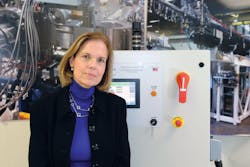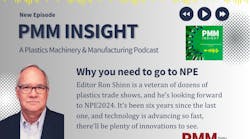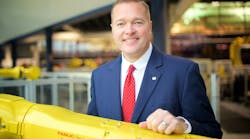Do everything possible to keep your customers happy. That’s the first business lesson Aline Alroy learned after graduating from college and enrolling in the management training program at Bloomingdale’s department store in New York.
It’s still her philosophy today.
“That’s something that really stuck with me,” Alroy said. “We try very, very hard to do anything and everything we can to keep our customers happy, even if in the short run it costs us money.”
Alroy joined High-Technology Corp., her family’s business, in 1986, and she has run the company for 27 years since her father passed away. She also is on the board of directors of the Plastics Industry Association and is treasurer of its Equipment Council. Alroy, who is a CPA, received her liberal arts degree from Princeton University in 1978 and an MBA from Rutgers University in 1986.
High-Technology manufactures and sells its proprietary continuous screen changers for melt filtration. Hitech automatic screen changers are used in a wide range of applications, including foam, blown film, biaxially oriented film, sheet, pipe, profiles, coextrusion, blow molding, filaments, fibers and pelletizing. They enable extrusion lines to run uninterrupted for months without disrupting production to change the filter screen.
Alroy discussed her career, her memories of working in the plastics industry, and how screen changers have evolved with Plastics Machinery Magazine Senior Staff Reporter Bruce Geiselman.
Where are you from?
I’ve been in New Jersey my whole life. We are located in and I’ve grown up in the northernmost part of New Jersey very close to New York City.
We could see the twin towers [of the World Trade Center] from here at work. On 9/11, we could see them burning and coming down. We could see the dense black cloud of smoke for two and a half months afterward. I take it very personally.
On that day, one of our engineers, his wife worked in lower Manhattan, and she called to say she had seen a plane fly into one of the towers. We turned on our radio to try to figure out what was going on. Once we heard what was happening, we went out into the parking lot. We could see the thick black smoke billowing. You could smell it, you could see it, and then you could see it smoldering for another two months. People in other parts of the country don’t realize how intense that day was. Absolutely everything came to a stop.
What was your first job after graduating from Princeton?
After Princeton, my first job was a management training program at Federated Department Stores, which owned Bloomingdale’s, a large department store chain. After that, I got my MBA at Rutgers University with a concentration in accounting.
How did you get involved in the plastics industry?
My father was a scientist and inventor. He was from Hungary — a brilliant guy with a Ph.D. in mechanical engineering.
He had spent his professional career in the field of high-speed, automated food packaging — first in canning and then transitioning into plastic packaging in the late ’60s. He worked for A&E Plastics in Los Angeles (now a Pactiv plant) and then for Monsanto, setting up some of the first BOPS [biaxially oriented PS] lines in the country.
He would get calls in the middle of the night because they were having problems with the hydraulic screen changer. It was a source of disruptions and downtime, so he was trying to think of something — a better mousetrap — to solve some of the problems generated by the existing technology at the time.
He left Monsanto and started his own consulting company in 1969. He was working on a number of inventions and projects in the beginning. The continuous screen changer is the one that really took off. I have no siblings, and eventually he got to the point in his life where it was a decision of whether to sell the business, or did I want to join and give it a try.
I had the business background. I was working for Arthur Andersen, a large accounting firm, at the time, but, obviously, I didn’t have the technical background. My dad said, “Well, you can try it, and if after a year you don’t like it, we can always look into selling the business. At least later on in life (I was in my twenties at the time), you won’t look back with regret and think ‘I should have tried it.’ ”
He said, “If you like it, then you can stay,” and here I am many years later.
How did you end up running the company?
When I first joined the company, I started in shipping and receiving and then worked in inventory management and purchasing, eventually spending most of my time in sales. My father died unexpectedly after only a few years of my working here, so I ended up at a relatively young age being left with the challenge of running the company and keeping it going. We have a lot of employees who had been with us a long time, and I certainly didn’t want to let anyone down in that regard, and I didn’t want to let my dad down. So, I just took it a day at a time, plowed ahead and here we are 27 years later.
This company was co-founded by my parents. I would say my dad had the technical brains and my mom, now 92, had the business brains. They were a good team. My main focus is on sales and product development.
Has it been difficult being a woman selling equipment in the plastics industry?
Not at all. In fact, I’ve become friends with many of our customers over the years. It’s actually been a lot of fun. I enjoy talking with people and learning about their lives. It’s so interesting to talk with customers all over the country and all over the world. We end up talking about our families. For example, my daughter is a vet and one of my customers in Russia, his son is a vet. Same with one of our customers in Missouri — his son is a vet. So, over the years of working together, these business relationships have turned into genuine friendships.
How did you get your polymer screen changer/filter technology education?
The way we work here at Hitech, there’s really no hierarchy. It’s our guys in the machine shop, it’s our engineers, and it’s myself. We work very collaboratively, and we work very collaboratively with our customers, who come to us with often quite challenging technical problems that they look to us to solve.
My technical education has come from being involved in all the projects that we’ve done over the decades, listening to all the smart people in the room, and absorbing information from that very collaborative process that we have.
We don’t have any formal meetings around here. We’ll sit around a table and talk through ideas. Because we’re small, we’re nimble; we can make decisions quickly, and we can try out new ideas quickly. I’ve learned by surrounding myself with talented people and by being involved in hundreds of projects.
How has the technology changed over the years?
Finding and retaining a qualified skilled work force — all the individuals that it takes to run a manufacturing plant — has become harder and harder for our customers. We see customers dealing with manpower shortages in every geographic region of the country.
In response, equipment has had to become more robust and easier to handle, easier to troubleshoot, and easier to service. Equipment manufacturers have had to take that upon ourselves — to develop machinery that requires the least possible amount of human intervention. As our customers’ resources became more limited, we have had to think of addressing that gap.
Many of our developments over the past 25 years have evolved by identifying anything that could possibly go wrong in the field or anything an operator and maintenance crew struggled with and finding a way to address those issues.
It sounds like you’re saying today’s screen changers are simpler and require less maintenance. Is that right?
Not necessarily simpler, but they have PLC-based controls that will help an operator quickly identify where to look if there’s a problem. With the PLC-based controls that we’ve developed, the information that the screen changer is able to convey to a maintenance person or an operator will tell them exactly what the problem is and where to go look to fix it.
We have had to design our equipment to be less reliant on the technical skills of the operators and the maintenance crew because on the plant level, they are very under-resourced. Most of our customers are working with fewer people than they ever did and less-skilled people than they ever had to before. So, we have to provide equipment that will guide the plant personnel to know what to look for and speed up the process of fixing any problem that arises.
How important is selecting the right screen changer?
I would say in a typical year 85 percent of our sales are repeat orders to existing customers. It all starts by being very careful in our quoting process. When someone calls with a given application, we are always honest. If it’s not a good fit, we tell them. I would rather not sell a screen changer than sell a screen changer for an application for which our technology is not a good fit and the customer won’t be satisfied.
There is no one kind of screen changer that is perfect for all applications. One has to know what the customer is trying to accomplish. One has to understand the process, the application, and fit the screen changer to the application. A lot of companies will, understandably, opt for a low-cost solution. That’s why manual and hydraulic screen changers tend to be the ones most commonly used.
If you think about it, extrusion is a truly continuous process. The companies who benefit the most from our type of technology are the ones who have a dedicated process, where they’re running non-stop for months at a time, and the only disruption to that process is a discontinuous screen changer. They then start to consider the benefits of a more sophisticated, more expensive type of screen changer that will eliminate process disruptions. That’s where we come in.
With a Hitech screen changer, what makes our unit different is that the breaker plate remains seated inside the screen changer — it doesn’t shuttle in and out of the melt flow. Instead, the only thing that moves is the 120-foot-long roll of filter screen that very slowly indexes across the face of the breaker plate, through the melt flow. The rate at which the screen advances automatically adjusts to keep the head pressure steady for an extended period — often months at a time.
If a processor calls and tells me that they have short production runs, that they’re shutting the line down every few days to make product changes, then they are not going to benefit from our technology. It’s important to know what the customer’s objectives are and how they run. We don’t want to recommend something that’s really overkill for what they’re trying to do.
Can you identify a company milestone?
Last year was 50 years that we have been in business. Given how many companies are not around anymore, weathering all the economic challenges and all the changes in our industry, just being here for 50-plus years is a bit of a milestone.
What is the most important business lesson that you have learned?
Something I learned very early on when I was working at Bloomingdale’s has always stuck with me. The first thing we were taught was if a customer comes in with a sweater that obviously has been worn for years and washed 100 times and it had a Macy’s tag inside and they want their money back, what do you do? Of course, being young trainees, we say, well, no way.
We were told, oh, no, on the contrary, you smile, and you give them their money back.
We asked, why on earth would one do that? We were [told] that if you upset a customer and he or she walks out of the store in a huff, it could take six months to get them back, if ever, and they’re going to go around badmouthing the store and telling their friends what a bad experience they had. On the other hand, if you give them $50 of store credit, then they are happy; they’ll stay in the store; they’ll spend the $50, and chances are they’ll spend even more money. That’s something that really stuck with me.
We honestly try to do anything and everything possible to keep our customers happy, even if in the short run we lose money. In the long run, maintaining that relationship is the most important thing for us. I think that is the reason we’re still here after 50 years. Everybody who works with us knows that they can call me any time of the day or night and I will do everything possible to help them.
Just the facts
Who is she: Aline Alroy, VP of sales for High-Technology Corp.
Headquarters: Hackensack, N.J.
Founded: 1969
Employees: 16
Age: 63
Company website: https://screenchanger.com/






